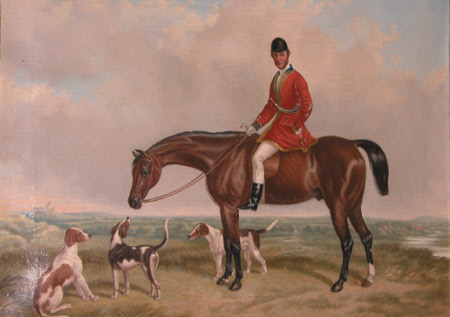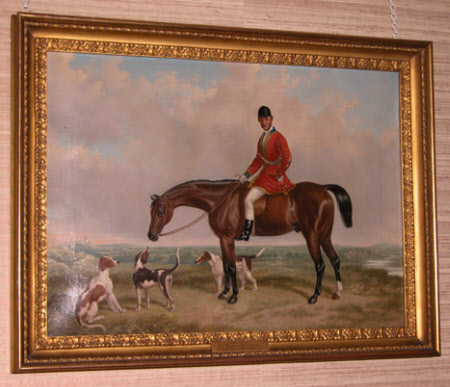The Master of the Royal Buckhounds, Charles F. Davis (c.1788-1866) riding ‘The Traverser’ with Windsor Castle in the distance
Gwilym Rosa (1808 – 1878)
Category
Art / Oil paintings
Date
1856
Materials
Oil on canvas
Measurements
580 x 759 x 70 mm
Place of origin
Windsor
Order this imageCollection
Anglesey Abbey, Cambridgeshire
NT 515753
Summary
Oil painting on canvas, The Master of the Royal Buckhounds, Charles F. Davis (c.1788-1866) riding ‘The Traverser’ with Windsor Castle in the distance by Gwilym Rosa also known as William Roos (1808 – 1878), 1856. An equestrian portrait, Charles F. Davis seated on a brown horse, which is turned to the left, head down sniffing at one of three hounds on the left of the painting, Davis in scarlet hunting coat, white breeches, black boots, and black hat, a hunting horn slung across his chest; distant view of countryside, with a glimpse of Windsor Castle in the far right. Blue, cloudy sky.
Provenance
Bequeathed to the National Trust by Huttleston Rogers Broughton, 1st Lord Fairhaven (1896-1966) with the house and the rest of the contents.
Credit line
Anglesey Abbey, The Fairhaven Collection (National Trust)
Marks and inscriptions
Verso: Label on back 'A portrait of Charles Davies, Her Majesties Huntsman, from life at Windsor, Oct 1856, Gwily[?m] Rosa pinxit'.
Makers and roles
Gwilym Rosa (1808 – 1878), artist
References
Bunt 1949 Cyril G. E. Bunt, Windsor Castle through Three Centuries, 1949, p.68: “PART I OIL PAINTINGS 61. ROSA GWILYM A Portrait from Life of Charles Davis, Her Majesty’s Huntsman, Windsor, 1856. Oil on canvas 18 ½ x 26. The Castle is seen in the distance to the left.” Anglesey Abbey, 1990-1992 [The National Trust; Robin Fedden] 1972, revised 1990, reprinted 1992., p.26: “The Upper Gallery Over half a lifetime Lord Fairhaven acquired a unique collection of views of Windsor. Comprising over 100 paintings, 150 watercolours and drawings and 500 prints, the collection faithfully charts the changes in the landscape and architecture of Windsor Castle over a period of three hundred and fifty years and must be one of the most complete topographical records of any site. Samuel Pepys called Windsor ‘the most romantique castle that is in the world’. It cast its spell on Lord Fairhaven at an early age, for his father owned Park Close, a house on the edge of Windsor Great Park, and later when he took up soldiering he was stationed at Windsor with his regiment, the 1st Life Guards. His first acquisitions were bought almost by chance for their historic and personal associations, but insensibly the ides of creating a complete topographical record from representative works of the artists of all periods caught his imagination. Windsor Castle and its surroundings are seen in every light and season, and from every quarter. Most painters have preferred to view the castle from the north where it rises nobly across the river, but others show what can be made of it less dramatic southern approaches. Yet other painters, such as W. Parrot with his record of the Montem celebrations in about 1848, introduce social and historical matter of a different but no less interesting sort. The earliest representations date from the reign of James I and it is understandable that the major seventeenth-century contributions when English topographical art was in its infancy, come from foreign artists. Clearly in a collection of this sort not every picture can pretend to be a work of art, but the level of executions remains surprisingly consistent. Among the eighteenth-century painters represented are Richard Wilson, Paul Sandby, and William Marlow; while distinguished painters of a later period include John Varley, David Cox, F.W.Watts, and Albert Goodwin.” Anglesey Abbey, 2006 [The National Trust] 2002, revised 2006, p.26: “Views of Windsor Lord Fairhaven had known Windsor since 1917, when his father bought Park Close, a house on the edge of Windsor Great Park. From 1916, when not at the front he was stationed at the Combermere barracks in Windsor with his regiment, the 1st Life Guards. He started collecting views of the castle as mementoes, but gradually became more systematic. By his death, he had assembled over 100 oil paintings, 150 watercolours and drawings and 500 prints, which together comprise the largest such survey outside the Royal Collection. They record the development over four centuries of the largest inhabited castle in the world, which has been a royal residence since the time of William the Conqueror. The 12th –century Round Tower dominates most of these views, the earliest of which dates from the beginning of the 17th century. Later artists represented include Paul Sandby, William Marlow and David Cox.”


